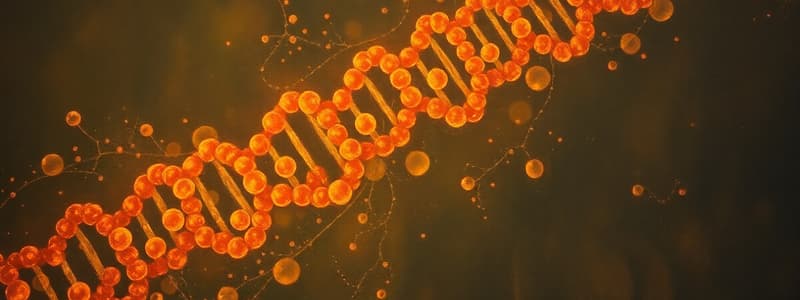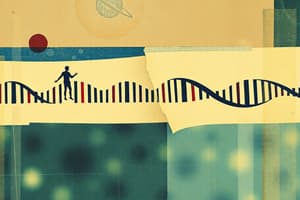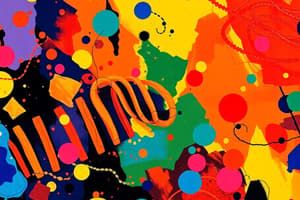Podcast
Questions and Answers
What is the primary function of a repressor protein in transcriptional control?
What is the primary function of a repressor protein in transcriptional control?
- To inhibit the binding of transcription factors
- To enhance the recognition of DNA sequences
- To decrease the level of mRNA production (correct)
- To actively promote mRNA synthesis
Which of the following best describes an inducible pathway?
Which of the following best describes an inducible pathway?
- It cannot be controlled by external factors.
- It is usually turned off until a substrate is present. (correct)
- It is usually turned on and remains active.
- It is active regardless of substrate presence.
What role does an inducer play in the regulatory mechanism of genes?
What role does an inducer play in the regulatory mechanism of genes?
- It enhances the binding of repressors to DNA.
- It allows the repressor to bind to the operator and inhibit transcription.
- It prevents the repressor from binding to the DNA. (correct)
- It activates the transcription of all genes indiscriminately.
How does a corepressor function in gene regulation?
How does a corepressor function in gene regulation?
What is the general role of allosteric DNA binding proteins in bacterial regulation?
What is the general role of allosteric DNA binding proteins in bacterial regulation?
What characterizes polycistronic mRNA in prokaryotes?
What characterizes polycistronic mRNA in prokaryotes?
Which RNA polymerase is responsible for synthesizing most mRNAs in eukaryotes?
Which RNA polymerase is responsible for synthesizing most mRNAs in eukaryotes?
What is the role of transcription factors in eukaryotic transcription?
What is the role of transcription factors in eukaryotic transcription?
What is the mechanism by which Rho protein terminates transcription?
What is the mechanism by which Rho protein terminates transcription?
Which of the following describes a key difference between eukaryotic and prokaryotic transcription?
Which of the following describes a key difference between eukaryotic and prokaryotic transcription?
How is the genetic code expressed?
How is the genetic code expressed?
What occurs during RNA processing in eukaryotes?
What occurs during RNA processing in eukaryotes?
Which statement accurately describes terminators in transcription?
Which statement accurately describes terminators in transcription?
Flashcards are hidden until you start studying
Study Notes
Transcription Unit
- Prokaryotic transcription units often contain more than one gene.
- One mRNA may contain information for more than one polypeptide.
- Genes of related pathways often cluster together.
- All genes in a pathway may be cotranscribed.
- Polycistronic mRNA contains instructions for multiple polypeptides.
Eukaryotic Transcription
- Uses three different types of RNA polymerases.
- RNA Polymerase I - Produces most rRNAs
- RNA Polymerase II - Produces most mRNAs
- RNA Polymerase III - Produces tRNAs and some rRNAs
- Eukaryotes do not use sigma factors.
- Eukaryotes use Transcription Factors - proteins bind to specific DNA sequences.
Transcription Termination
- Terminators stop RNA polymerase.
- Two main Types:
- Intrinsic terminators
- Sequence-determined
- Inverted repeats
- Rho-dependent
- Rho binding sequence
- Rho protein binds RNA
- Intrinsic terminators
Rho Termination
- Rho RNA helicase binds to a specific "Rut" site upstream of the promoter.
- Moves along RNA until "traps" RNA Polymerase.
Genetic Code
- The genetic code is expressed in terms of RNA.
- Codon - Three-letter word for each amino acid.
- A single amino acid may be encoded by several different but related codons.
- DNA stores a coded language.
- Language is spelled out in linear form.
- Only has 4 characters (G, C, A, T).
- Each "word" is only 3 letters long!
Translation
- mRNA is used to direct protein synthesis.
- Occurs on ribosomes with the participation of tRNA
Gene Regulation - Levels
- Transcriptional
- Translational
- Post-Translational
- Constitutive - Continuous expression
Transcriptional Control
- Often involves DNA binding proteins.
- Recognize specific sequences of DNA.
- Two main types of control:
- Negative Control - Decreases the level of mRNA.
- Binding of a repressor to an operator sequence
- Repression - Corepressor protein
- Induction - Inducer
- Positive Control - Increases the level of mRNA.
- Binding of an activator to an activator binding site
- Activator - DNA binding protein
- Negative Control - Decreases the level of mRNA.
Two Types of Pathways
- Inducible - Usually turned off. The presence of a substrate turns it on.
- Repressible - Usually turned on. The presence of a product turns it off.
Bacterial Regulatory Proteins
- Allosteric DNA Binding Proteins
- Bind to DNA
- Bind to an effector molecule.
- Effector influences binding to DNA.
- Inducer - Prevents repressor from binding.
- Corepressor - Activates repressor, allowing binding.
Studying That Suits You
Use AI to generate personalized quizzes and flashcards to suit your learning preferences.



